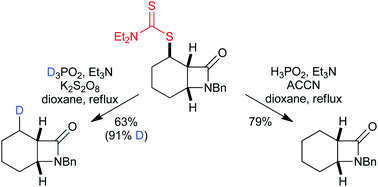Radical-mediated reduction of the dithiocarbamate group under tin-free conditions†
Abstract
Reductive desulfurisation of dithiocarbamates is conveniently achieved using H3PO2–Et3N–ACCN in refluxing

* Corresponding authors
a
School of Chemistry, University of Birmingham, Edgbaston, Birmingham B15 2TT, UK
E-mail:
r.s.grainger@bham.ac.uk
Fax: +44 (0) 121 4144403
Tel: +44 (0) 121 4144465
b GlaxoSmithKline, Gunnels Wood Road, Stevenage, Herts SG1 2NY, UK
Reductive desulfurisation of dithiocarbamates is conveniently achieved using H3PO2–Et3N–ACCN in refluxing

 Please wait while we load your content...
Something went wrong. Try again?
Please wait while we load your content...
Something went wrong. Try again?
C. McMaster, R. N. Bream and R. S. Grainger, Org. Biomol. Chem., 2012, 10, 4752 DOI: 10.1039/C2OB25434D
To request permission to reproduce material from this article, please go to the Copyright Clearance Center request page.
If you are an author contributing to an RSC publication, you do not need to request permission provided correct acknowledgement is given.
If you are the author of this article, you do not need to request permission to reproduce figures and diagrams provided correct acknowledgement is given. If you want to reproduce the whole article in a third-party publication (excluding your thesis/dissertation for which permission is not required) please go to the Copyright Clearance Center request page.
Read more about how to correctly acknowledge RSC content.
 Fetching data from CrossRef.
Fetching data from CrossRef.
This may take some time to load.
Loading related content
